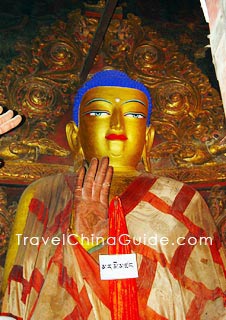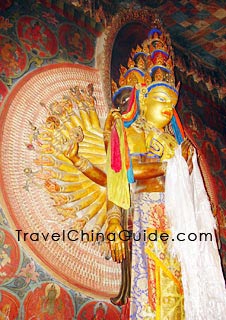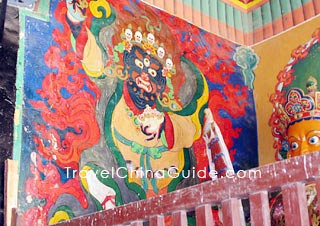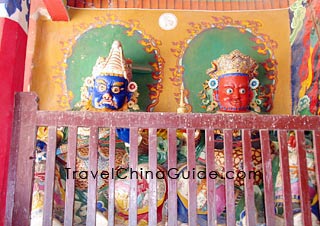 | | Statue of Sakyamuni | |
 | | Statue of Avolokiteshvara | |
Visitors to Tibet will inevitably feel drawn to one or more of the numerous monasteries in order to discover something of the mystery and traditions of Tibetan Buddhism. These buildings house many statues and illustrated thangkas [scrolls] and exotic murals, which at first sight may be somewhat confusing. The Buddha has many manifestations and there are helpful clues in the iconography to enable the viewer recognize the more important of these.
Sakyamuni, the Indian prince who in the 5th century BC founded Buddhism, is featured in almost every monastery. He is usually depicted in a cross legged seated position upon a lotus throne. The legs will be crossed with the right leg over the left. His hands are placed in a symbolic position or mudra. Typically, the position will be with the left hand open palm upwards, resting in his lap with the right hand palm downwards across the right leg. This mudra is the sign for calling the earth to witness. The figure will be draped in a robe, often blue in color and which leaves the right arm and right breast bare. The hair will be in a top knot. When this image is in the form of a mural or in a thangkra, the head will be surrounded by a halo.
Avolokiteshvara, called Chenrezi or Chenrezig in Tibetan, is the Bodhisattva of Compassion. This figure is of great importance as the deity is the patron saint of Tibet. The image, which can be found virtually everywhere, is in a standing position and has many arms and eleven heads, which are arranged in the form of a pyramid. The hands are placed in a variety of mudras. Greatly revered by all Buddhists, as he is said to postpone his own fulfillment until he has helped everyone on earth to achieve emancipation, his head was said to have spilt due to his concern for the wickedness in the world. Each segment reformed into a complete head, enabling him to look in all directions.
Tsong Khapa, is the founder of Gelugpa (the Yellow Hat sect) and a great reformer. Depicted in a cross legged position, his hands are raised before his chest in a mudra that symbolizes his teaching of the law. Flanked on either side by a lotus flower, he may also appear with his two disciples. He wears a yellow cap with long flaps on each side.
The Four Heavenly Kings are commonly depicted as statues or murals guarding the entrance to the monastery. They each guard one of the cardinal points of the compass. They have fiery haloes and are shown against a background of clouds. The East has a white face and holds a musical instrument, the South has a blue face and carries a sword, the West has a red face and carries either a stupa or a snake while the North has an orange colored face and carries an umbrella. In some locations the items carried by these deities may vary.
 | | Four Heavenly Kings in murals | |  | | Statues of Four Heavenly Kings | |

Tibetan Buddhism
- Last updated on Apr. 08, 2021 -



